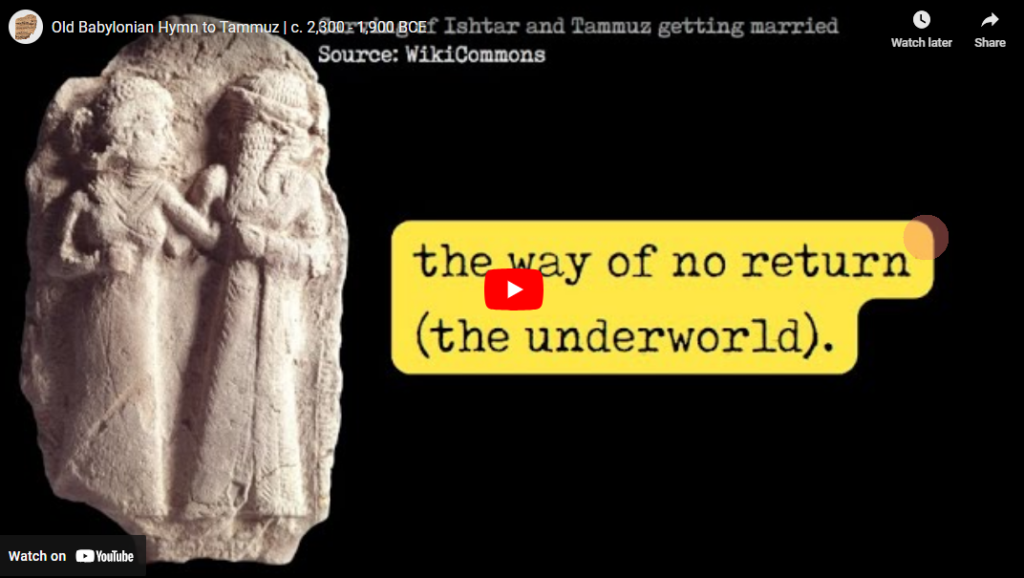The Passage
14 Then he brought me to the entrance of the north gate of the house of the Lord, and I saw women sitting there, mourning the god Tammuz. 15 He said to me, “Do you see this, son of man? You will see things that are even more detestable than this.” (Ezekiel 8:14)
The context of the passage is that Ezekiel is being taken through Jerusalem by the Lord, and God is showing him various forms of idolatry and how the people have turned away from him. Among the worst of the idolaters is a group of women weeping for Tammuz. But the text doesn’t explain what this mean. It assumes that we know. However, since the modern world is so far removed from the ancient world of the Old Testament, most people are unfamiliar with the mythology involving Tammuz.
In this short article we will explain who Tammuz is and why the women are weeping for him.
Tammuz Mythology
The story of Tammuz (also known as Dumuzid), is an ancient Mesopotamian myth centered around a young god associated with fertility, agriculture, and the cycle of life and death. Tammuz’s story is often depicted as a tragic tale, and his myth shares similarities with other dying-and-reviving god myths from different cultures.
In the original Sumerian version of the myth, Tammuz was the son of the sky god Enlil and the goddess Ninlil. He was a handsome and kind young shepherd who won the love of the fertility goddess Inanna (Ishtar in later texts). Tammuz and Inanna fell deeply in love, and their union was believed to bring prosperity and abundance to the land.
However, tragedy struck when Tammuz died prematurely. The circumstances of his death are not explicitly described in the myth, but it is suggested that he may have met a violent end. This untimely death plunged the world into grief, and Inanna was particularly devastated by the loss of her beloved.
In order to solve the problem created by his death, Inanna descended into the Underworld to retrieve Tammuz and bring him back to life. This is where we get the popular myth titled “Innana’s/Ishtar’s Descent To Hades/Underworld“. As Inanna entered the realm of the dead, she had to pass through seven gates and surrender her divine attributes, similar to Ishtar’s journey. However, the details of Inanna’s encounter with her sister Ereshkigal and the subsequent events are not as well-documented in surviving texts.
His death was associated with the annual cycle of the seasons, where his departure to the Underworld corresponded to the arrival of the hot and dry summer months, and his return symbolized the rejuvenation of the land during the cooler and wetter seasons. In some versions of the myth, Tammuz is granted a limited time each year to return to the world of the living, allowing fertility and life to flourish. This cyclical pattern of death and rebirth contributed to the myth’s significance in Mesopotamian religious beliefs and rituals related to agricultural cycles and the changing seasons.
The story of Tammuz served as a an explanation in ancient Mesopotamia as to why there were season and a cycle of death and life. The mourning ritual for Tammuz was because he was connected with the fertility of the land and the fertility of the womb. Thus, those seeking to bare children would participate in the rituals associated with both Tammuz and Ishtar. This, of course, was considered idolatry.
However, it should be noted that in the Hebrew calendar there is a month dedicated to Tammuz. One must assume that they adopted this naming from their neighbors in the ancient Near East or that the veneration of Tammuz was more common than what we are told in the Old Testament.
Various Hymns to Tammuz
Like all long-standing religions, there were hymns and prayers that become popular over the year. Two such hymns provide insight about why the women were weeping for Tammuz.
Hymn for Tammuz #1
Where are tied the ewe and her lamb?
Where are bound the she-goat and her kid?
Ewe and her lamb they carry away as spoil.
She-goat and her kid they carry away as spoil.
Ewe and her lamb they cause to be slaughtered.
She-goat and her kid they cause to be slaughtered.
I (Tammuz), a hero, go to the conflict, the way of no return (the underworld).
Alas, O hero, lord of healing.
Alas, my lord, my Damu.
Alas, O son, lord Gishzida
Alas, Lamga, lord of the net.
Alas, O prince, lord of prayer.
Alas, god of wailing and shining eyes.
Alas, my heavenly waller (?)
Alas, Dagalushumgalanna
Alas, brother of the mother of Belit-seri.
He has gone, he has gone to the bosom of the earth.
And the dead are numerous in the land.
With wailing for him in the day of gloom has he gone.
In the month of the year which brings not peace, hast thou gone.
Thou hast gone on a journey that makes an end of thy people.
With sighing for Damu, the lord,
Has the hero gone unto the far away land which is not revealed.
Hoe long shall the springing of vegetation be restrained?
How long shall the putting forth of leaves be held back ?
My city is oppressed
The shepherd sits in desolation.
In the city the laws of my land are suppressed.
From the secret chamber thou hast gone forth.
Thou, lord, from the secret chamber hast gone forth.
Alas, O hero, lord of healing.
Alas, my lord, my Damu.
Alas, O son, lord Gishzida.
Alas, Lamga, lord of the net.
Alas, O prince, lord of prayer.
Alas, god of wailing and shining eyes.
Alas, thou of the yearly wailing
Alas, Tammuz.
Alas, brother of the mother of Belit-seri.
In his infancy in a sunken boat he lay.
In his manhood in the submerged grain he lay.
In a storm from the south, and tempest, he lay.
In rest he lay not.
[Remainder of tablet broken, and of uncertain meaning.] [1]Sameul Rolles Driver, Cuneiform Parallels to the Old Testament, 179-182
Hymn for Tammuz #2
The lord of destiny abides no more.
The lord of destiny abides no more.
Tammuz, the lord of destiny abides no more.
The lord of destiny abides no more.
Tammuz, he of wailing abides no more.
The lord of destiny abides no more.
I am queen (this is a title), my consort abides no more.
My Damu abides no more.
Dagakishumgalanna abides no more.
The lord of Aralu abides no more.
The lord of Durgurgurru abides no more.
The shepherd, lord Tammuz abides no more.
The lord, shepherd of the folds, abides no more.
The consort of the queen of heaven abides no more.
The lord in the cattle stalls abides no more.
The brother of the mother Belit-seri abides no more.
He who causes the sprouting of the Land abides no more.
The heroic lord of the land abides no more.
When he slumbers, the sheep and lambs slumber also.
When he slumbers, the she-goats and the kids slumber also.
As for me (Tammuz) to the abode of the abyss, I set my thoughts.
To the abode of the exalted one I set my thoughts.
“O hero, my lord, ah me” I will say.
“Food I eat not” I will say.
“Water I drink not” I will say.
“My good maiden”, I will say.
“My good husbandmen” I will say.
Thy lord, the exalted, unto the nether world has taken his way.
Thy lord, the exalted, unto the nether world has taken his way.
Because of the exalted one of the nether world,
him of the radiant face, yea radiant,
Of the exalted one of the nether world, him of the dovelike voice, yea dove like,
Because of the exalted one, because of the lord.
Food I eat not because of the lord.
Water I drink not because of the lord.
My good maiden, [I lack] because of the lord.
My good husbandman, [I lack] because of the lord.
The hero, your lord, has suffered destruction,
The god of grain, the child, your lord, has suffered destruction,
His sacred look bestows peace no more,
His sacred voice bestows salvation no more.
In his resting place, like a dog he slumbers.
My lord in his resting place, like a raven slumbers.
In solitude, he himself is.
My lord! for whom the wail is raised.
[Forty-one lines, a psalm on the flute to Tammuz.][2]Sameul Rolles Driver, Cuneiform Parallels to the Old Testament, 182-185 <– scribal note for performing the hymn on the flute.

